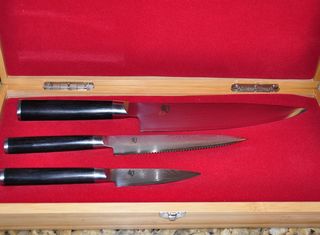By Dr. Ken Broda Bahm:
If that commercial for the knife set just laid it all out at the start, it would sound like this: “Okay, here is the deal, you get the knives, the storage block, an extra set of steak knives, free sharpening for life, and free shipping if you call in the next hour.” But that isn’t very exciting. Instead, over the course of a relatively long commercial message, the knife seller will trot out each of these perks in sequence, so just as you are wondering if the knife set itself is worth it, you hear “There’s More!” and you’re given yet another benefit.
As cheesy as it sounds, the technique works. A sequenced delivery of arguments is better than a more straightforward listing of arguments, because it helps the target customers get past any doubts that they may be having over the sale. New research shows that the same principle applies beyond the world of advertising, and works in the world of legal evidence as well. This post will take a look at the study and draw out a couple of important implications that apply to the structure and content of your opening statement and trial plan.
The Research:
As discussed in a new issue of Scientific American, the study found that evidence is perceived as stronger when it is parcelled out one step at a time instead of being shown all at once. Whitman & Woodward (2011) looked at how study participants rated the relative probability of a proposition being true. The researchers found that when the evidence was presented in three chunks over time, it was viewed as stronger than if it was presented all at once. The authors believe that, when receiving evidence in divided segments, participants are encouraged to place greater salience on individual pieces of evidence and to spend more time processing the evidence. One other explanation is that the subsequent information exerts a kind of “disruptive” effect that helps address jurors who are mentally responding to the message. In other words, to return to the steak knives example, after a minute or so of the advertisement you might be thinking, “Hmm…I don’t know if these knives are well-made, the tests might be staged, and $29.99 is a lot of… wait, I get two sets of knives for that?” The same process is likely to occur in a juror’s head. We know that as jurors hear the evidence, they evaluate, and all things considered, they’ll often spend more time thinking about why you are wrong than about why you are right. An added piece of evidence could then serve as a productive distraction that increases the amount of attention given to the second piece of evidence, while possibly reducing the amount of critical focus on the first piece of evidence.
The Recommendations:
1. Do think about saving some for later. Your first impulse, in opening or in case structure, may be to simply disgorge all of the great evidence you have, in the hope of building an inescapable advantage. But the better strategy is to look for the chance to hold back a sizzling fact or two to address the doubts that your jurors may have later on. You all know the moment: Someone shares a juicy bit of favorable testimony in the war room, and it is a celebration (“Really? That is fantastic! We have to emphasize that…”), but instead of emphasizing it right out of the gate, think about what the effect might be if you saved it until the key witness testifies. That might be just the thing to wake the jurors up and provide a great memorable moment in trial.
2. But don’t take it too far. Beyond the fact that no judge is going to grant your request to divide your opening into five-minute chunks dispersed throughout your case, there is one other complication to the one-piece-at-a-time approach. That is the fact that first impressions tend to be durable. While the old canard that 80 percent of jurors make up their minds in opening statement turns out to be an urban myth (see the personal research reported in Karen Lisko’s book), it is true that most jurors will form an outlook on your case based on what they hear early on. So, if you save too much of the good stuff for later, you risk jurors developing an early perception of a weak case, a perception that could color what they hear down the road.
So bottom line: You should save some good evidence for later, if possible, but not at the cost of making your case look weak or incomplete at the start.
______
Related Posts:
- Avoid the “And Another Thing…” Style in Rebuttal
- Your Opening: Tell It Like a Story, but Tailor It Like a Strategy
- Remember That Argument Isn’t The Most Important Part of Closing
______
 Whitman JC, & Woodward TS (2011). Evidence affects hypothesis judgments more if accumulated gradually than if presented instantaneously. Psychonomic bulletin & review, 18(6), 1156-65 PMID: 21822566
Whitman JC, & Woodward TS (2011). Evidence affects hypothesis judgments more if accumulated gradually than if presented instantaneously. Psychonomic bulletin & review, 18(6), 1156-65 PMID: 21822566
Photo Credit: Cubanrefugee, Flickr Creative Commons
